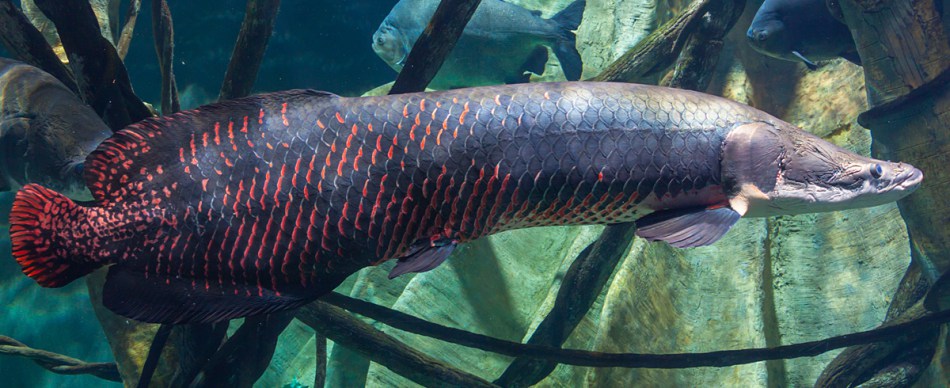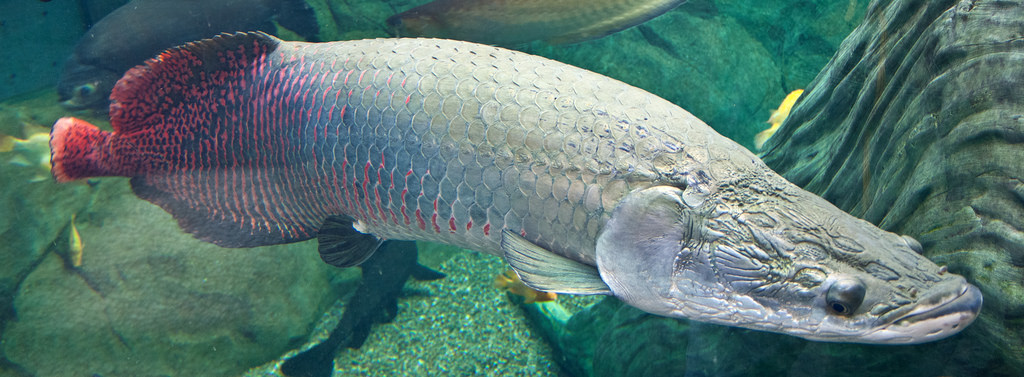The arapaima is South America’s largest freshwater fish! They can grow up to 15 feet and can weigh about 440 pounds but most are about half that size. Its local name, pirarucu, derives from the indigenous words for “pira” meaning “fish” and “urucum” meaning “red”. The arapaima, pirarucu, or paiche are any large species of bonytongue in the genus Arapaima native to the Amazon and Essequibo basins of South America.

The Arapaima: Image Source – http://guyanainc.biz/daily-updates/feature-animal-the-arapaima/
Species of Arapaima
- Arapaima agassizii
- Arapaima gigas
- Arapaima leptosoma
- Arapaima mapae
- Arapaima arapaima
About This Giant Fish
The usual length of an arapaima can reach up to 6 feet 7 inches. As a result of overfishing, larger arapaimas are seldom found in the wild. The arapaima is torpedo-shaped with large blackish-green scales and red markings. It is streamlined and sleek, with its dorsal and anal fin set near its tail. Their scales have a mineralized, hard, outer layer with a corrugated surface under which lie several layers of collagen fibres in a Bouligand-type arrangement.
There is a solution that allows the arapaima to remain mobile while heavily armored. How is this done? Thinking about a similar structure to plywood, the fibres in each successive layer of the arapaima are oriented at large angles to those in the previous layer, this increases toughness. The hard, corrugated surface of the outer layer, and the tough internal collagen layers work synergistically to contribute to their ability to flex and deform while providing strength and protection.

Image Source: http://blog.flickr.net/2014/08/13/wildlife-wednesday-endangered-arapaima/
Did You Know?
In addition to gills, the arapaima has a modified and enlarged swim bladder, composed of lung-like tissue, which enables it to extract oxygen from the air. The arapaima has a fundamental dependence on surface air to breathe. Because the arapaima is an air-breather, it has to use its labyrinth organ which is rich in blood vessels and opens into the fish’s mouth. This is an advantage in oxygen-deprived water that is often found in the Amazon River.
Scientific Classification of the Arapaima
- Kingdom: Animalia
- Phylum: Chordata
- Class: Actinopterygii
- Order: Osteoglossiformes
- Family: Arapaimidae
- Genus: Arapaima
J. P. Müller, 1843
Tip:
Conservation scientist Dr. Lesley de Souza is working with the people of Guyana to establish a new protected area. Their goal is to safeguard a watershed for animals like the arapaima. Her fieldwork in the remote Rupununi wetlands of Guyana was a first-of-its-kind study of the migratory patterns of arapaimas.
Diet of the Arapaima
Arapaimas usually eat crustaceans, fish and even small land animals that walk near the shore. In the wild, the arapaima eats mostly fish but is also known to eat fruits, seeds, insects, birds and mammals found on the surface of the water.
Habitat of the Arapaima
The arapaima is able to survive in oxbow lakes with dissolved oxygen as low as 0.5 ppm; they may leap out of the water if they feel constrained by their environment or harassed. Arapaimas are hard to catch and live in remote areas; they pile up in the rain forest rivers of the South America’s Amazon Basin and nearby lakes and swamps. They can also be found in the Essequibo river of Guyana.
Reproduction of the Arapaima
The arapaima lays its eggs during the months when water levels are low or beginning to rise. They usually build their nest in muddy-bottomed areas around 50 centimetres wide and 15 centimetres deep. As the water rises, the eggs hatch and the offspring have the flood season during May to August to prosper such that yearly spawning is regulated seasonally.
Lifestyle of the Arapaima
The female arapaima helps to protect the male and the young by circling them and fending off potential predators. The male arapaima is a mouthbrooder (the care given by some groups of animals to their offspring by holding them in the mouth of the parent for extended periods of time) – this is excellent since the young are protected in their father’s mouth until they are older. The arapaima can live for up to 20 years and sexual maturity is reached after about 4 or 5 years of age.
Arapaima’s & Humans
The arapaimas tongue is said to have medicinal qualities. It is dried and combined with guarana bark, which is grated and mixed into water – this is good for killing intestinal worms. The bony scales are used as nail files. For some, the arapaima is considered an aquarium fish, one that requires substantial space and food. On the other hand, some enjoy the arapaima as food – they produce boneless steaks and are considered a delicacy. Note that conservation efforts for arapaima are strong in Guyana. The population monitoring, research and conservation are led by the North Rupununi District Development Board.
Arapaimas in Guyana
Arapaimas are extremely powerful; the skulls of these ancient river dwellers are like battering rams. The arapaima looks like some prehistoric monster; their scales are so large that the piranha’s teeth crumbles upon it. There is a way to see these giants – Megatour arranges tours to experience the arapaimas; email address: [email protected].
Tour:
- Day 1 – Arrival at the airport in Georgetown, have a meeting with the guide, transfer to the hotel and rest.
- Day 2 – Transfer to the Ogle airport. Depart at 8:30am to the village of Kurupukari. Flight time of 1 hour. The Cessna Caravan 208 aircraft (Seating capacity 14 persons). Transfer by boat to the Lodge for about 2 hours.
- Day 3 -10 – The first few days for exploring the river and fishing techniques, fishing, return to the Lodge, then the alloy up river, overnight in tent camps.
- Day 11 – Return to the Lodge and transfer to the village of Kurupukari flight to Georgetown. Overnight at hotel.
- Day 12 – Transfer to the international airport. Departure.
The district will be the upper reaches of the Essequibo river. The tour duration is 12 days/11 nights/ 8 fishing days. Eight to eleven people are welcome – this would be a trip that is worth taking. The arapaima is an absolutely stunning giant that can be found in the deep waters of Guyana.
Article References:
- https://nationalzoo.si.edu/animals/arapaima
- https://www.nationalgeographic.com/environment/freshwater/arapaima/
- https://www.fishbase.de/identification/SpeciesList.php?genus=Arapaima
- https://www.fieldmuseum.org/blog/preserving-migration-giants-guyanas-arapaima
- https://www.sheddaquarium.org/Conservation–Research/Field-Research/around-the-globe/Project-Guyana-Saving-Arapaima/
- http://mega-tour.org/en/fishing/gayana/za-gigantskoy-arapaymoy/
- https://en.wikipedia.org/wiki/Arapaima
Article Cover Image: https://blog.nationalgeographic.org/2014/06/26/arapaima-conservation-its-happening-at-the-local-level-in-guyana/







